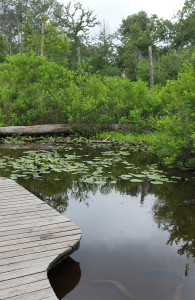Five miles of walking trails weave through relatively wild wetland forest, small ponds and meadow. The trails are wide and paved with wood chips and boardwalks that make it a pleasant stroll even after a heavy rain. Reflecting its educational focus, the arboretum abounds with nature guides and labels on its diverse flora.
The drought that devastated Memorial Park’s trees did not mar the arboretum’s landscape as severely, but felled dead trees abound along the trail. Instead of being hauled away, they are again slowly becoming part of the forest floor.
Outer Loop / Couch Birding trails. The longest trail at two miles, the Outer Loop circles the border of the arboretum. Unlike most of the other trails, it is more of a dirt road or path in places and popular with people walking their dogs or taking a brisk hike in lieu of a jog. Parts of it graze the edge of civilization, so you’ll hear the West Loop traffic on its west side and Memorial Drive on the north. But the south offers the solitude of a quiet forest and a side trail down to the Charlotte Couch Birding Platform, which overlooks Buffalo Bayou.
Inner Loop Trail. Beginning a short distance from the Nature Center, the Inner Loop is a boardwalk-and-wood-chip trail with heavy forest canopy in places, though not as dense as it was before the drought. It’s a good place to start almost any hike because five or six short trails branch off from it. At its far end is the showpiece of the arboretum – a developing meadow and turtle pond that wraps around an island of forest.
Meadow and Pond. The far end of the Inner Loop Trail opens out on a large meadow of native grasses and wildflowers that hugs the arboretum’s largest pond. A couple of short trails merge to create a loop around the meadow. It is an ideal place to stop and take in a diverse landscape of forest, meadow and wetlands. By early summer, green vegetation blankets the pond, where small fish dart about the shallows. Turtles line the banks and poke their heads between the leaves floating on the water. Songbirds swoop along the edge of the forest and into the meadow. Wading egret or herons often troll among the reeds for the small fish. A large observation deck, big enough for a small party, offers a secluded view of the pond. Along the trail there are boardwalks, benches and a small bridge across the pond. If you get there early in the morning or in the late afternoon during the week, you can often have the meadow to yourself and quietly read a book. Occasionally you’ll hear the roar of a train passing to the east, but it’s just a reminder that this is an oasis in the midst of the city.
R.A. Vines Trail. Just off the Inner Loop, the R.A. Vines Trail leads through a shallow marsh and crosses a ravine. Its a haven for dragonflies, aquatic insects, lizards, frogs and small fish and therefore a bit of a cafeteria for herons and other wetland birds. At times in the summer, its a haven for mosquitoes, too, so bring your repellant.
Alice Brown / Coggie Pearson trails. The short Alice Brown loop starts at the Nature Center and follows the entrance road to a small pond. An observation deck nearby overlooks a steep ravine, something you don’t see too often among Houston’s flatlands. The Coggie Pearson trail climbs down the ravine, connecting the Alice Brown and Vines trails. At the bottom, sycamores tower over a seasonal creek.
The Nature Center has the trappings of a small interactive museum and includes a reading library, community rooms, gift shop and, importantly, restrooms. The Arboretum’s calendar is a busy one, with children’s and adult education programs, special camps, tours and other events.
ARBORETUM GALLERY













You must be logged in to post a comment.